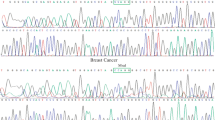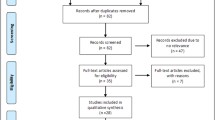Abstract
Breast cancer (BC) is one of the most common causes of death among women, and second in Iran. The objectives of this study were to determine the frequency of RAD51 G/C polymorphism in patients with breast cancer. We evaluated these polymorphisms and effects on the breast cancer risk association in a Iranian sporadic population-based case–control study of 294 breast cancer cases and 315 controls using a PCR–RFLP-based assay. Analyses of affected and controls show that homozygote genotype RAD51 GG has the highest frequency in both groups (33.3 in patients and 41.4 in control group). Genotype RAD51 GG most risk factor were in our population: [CC/GC odds ratio, 0.364 (95 % confidence interval; CI, 0.168–0.788) p = 0.009, CC/GG odds ratio, 0.828 (95 % CI, 0.411–1.668) p = 0.596], GG/GC odds ratio, 2.276 (95 % CI, 1.497–3.460) p = 0.001]. There was a significant association of breast cancer risk with RAD51 GG and CC polymorphism.


Similar content being viewed by others
References
Richardson C (2005) RAD51, genomic stability, and tumorigenesis. Cancer Lett 218:127–139
Tsuzuki T, Fujii Y, Sakumi K, Tominaga Y, Nakao K, Sekiguchi M, Matsushiro A, Yoshimura Y, Morita T (1996) Targeted disruption of the Rad51 gene leads to lethality in embryonic mice. Proc Natl Acad Sci USA 93:6236–6240
Shin MH, Lee KM, Yang JH, Nam SJ, Kim JW, Yoo KY, Park SK, Noh DY, Ahn SH, Kim B, Kang D (2005) Genetic polymorphism of CYP17 and breast cancer risk in Korean women. Exp Mol Med 37(1):11–17
Artamonov VV, Liubchenko LN, Shabanov MA, Babenko OV, Nemtsova MV, Zaletaev DV (2003) Association of polymorphism of genetic markers of CYP19 and CYP17 with sporadic breast cancer. MolBiol (Mosk) 37(6):975–982
Gonzalez R, Silvia JM, Dominguez G, Garcia JM (1999) Detection of loss of heterozygosity at RAD51, RAD52, RAD54 and BRCA1 and BRCA2 loci in breast cancer: pathological correlations. Br J Cancer 81:503–509
Wick W (1996) Evidence for a novel tumor suppressor gene on chromosome 15 associated with progression to a metastatic stage in breast cancer. Oncogene 12:973–978
Chen JJ, Silver D, Cantor S, Livingston DM, Scully R (1999) BRCA1, BRCA2, and RAD51 operate in a common DNA damage response pathway. Cancer Res 59:1752–1756
Teo MT, Landi D, Taylor CF (2012) The role of microRNA-binding site polymorphisms in DNA repair genes as risk factors for bladder cancer and breast cancer and their impact on radiotherapy outcomes. Carcinogenesis 33(3):581–586
Cole DJ, Rajendra E, Roberts-Thomson M. Interrogation of the protein–protein interactions between human BRCA2 BRC repeats and RAD51 reveals atomistic determinants of affinity. PLoS Comput Biol. 2011;7(7)
Falvo E, Strigari L, Citro G, Giordano C (2011) Dose and polymorphic genes xrcc1, xrcc3, gst play a role in the risk of article developing erythema in breast cancer patients following single shot partial breast irradiation after conservative surgery. BMC Cancer 12(11):291
Romanowicz H, Smolarz B, Baszczyński J (2010) Genetics polymorphism in DNA repair genes by base excision repair pathway (XRCC1) and homologous recombination (XRCC2 and RAD51) and the risk of breast carcinoma in the Polish population. Pol J Pathol 61(4):206–212
Paek AR, You HJ (2011) GAIP-interacting protein, C-terminus is involved in the induction of zinc-finger protein 143 in response to insulin-like growth factor-1 in colon cancer cells. Mol Cells 32(5):415–419
Luisel J Ricks-Santi1, Lara E Sucheston, Yang Yang (2011) Association of Rad51 polymorphism with DNA repair in BRCA1 mutation carriers and sporadic breast cancer risk. BMC Cancer 11:278
Amanda B Spurdle Felicity Lose1, Paul Lovelock (2006) Variation in the RAD51 gene and familial breast cancer, Breast Cancer Res 8(3)
Romanowicz-Makowska H, Smolarz B, Zadrozny M (2006) Analysis of RAD51 polymorphism and BRCA1 mutations in Polish women with breast cancer. Exp Oncol 28(2):156–159
Acknowledgments
We would like to thank the all patients for their kind collaborations in our projects, the Islamic Azad University for supporting of this Research. Finally, we appreciate to thank from head and physicians of Special Medical Centre, Tehran, Iran, that help us during this project.
Author information
Authors and Affiliations
Corresponding author
Rights and permissions
About this article
Cite this article
Hosseini, M., Houshmand, M. & Ebrahimi, A. RAD51 polymorphisms and breast cancer risk. Mol Biol Rep 40, 665–668 (2013). https://doi.org/10.1007/s11033-012-2105-y
Received:
Accepted:
Published:
Issue Date:
DOI: https://doi.org/10.1007/s11033-012-2105-y




